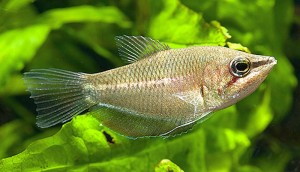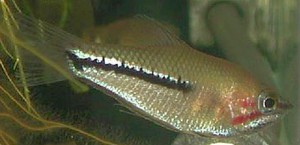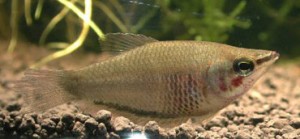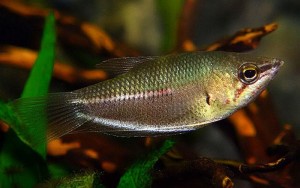Giant Chocolate Gourami (Sphaerichthys acrostoma) are known to tropical fish keeping enthusiasts as the Sharp Nosed Gourami, Moonlight Chocolate Gourami, Black Lined Chocolate Gourami, and Black Tailed Chocolate Gourami. They are found only within the Indonesian parts of the island of Borneo and appear to be well distributed within the Mentaya River drainage system near the town of Sampit and further south.
Giant Chocolate Gourami grow to almost 4″ in length are are primarily found in peat swamps and forested blackwater streams littered with rotting leaves and fallen tree branches that are typically stained a dark brown to almost black color by the humic acids and other chemicals released from decaying organic matter.
The decomposition results in a negligible dissolved mineral content in the water and a pH value as low as 3.0 or 4.0. The dense jungle growth and the rainforest canopy allows very little light to penetrate the surface of the water, letting only low light loving plants like Utricularia, Cryptocoryne, Blyxa, Barclaya, Eleocharis, Utricularia, and Lymnophila to grow.
Giant Chocolate Gourami have a high, flattened, moderately elongated body with a long dorsal and anal fin, and low filamentous pelvic fins. The overall body color is bronze with slightly networked scales, dark fins, and a light throat. There are two black cherry colored lines that extend from the tip of the snout through the eye, to the end of the gill cover.
When excited, males show a bright lateral band that extends from the caudal fin to the middle of the body. Females lack this band but have a series of dark vertical lines on the lower front of the body in the abdominal region and along the base of the anal fin.
Females have a uniformly brown body with some red pigmentation in the throat and the unpaired fins. The
females also have an overall more acuminate head shape than males and a uniformly straight lower jaw profile.
Like others in the suborder Anabantoidei, Sphaerichthys acrostoma possess a labyrinth organ that allows them to breathe atmospheric air and survive in oxygen depleted water conditions.
Some species collected along with Giant Chocolate Gourami in the tannin stained jungle streams included Betta foerschi, Parosphromenus parvulus, Hemirhamphodon chrysopunctatus, Pectenocypris korthausae, Puntius foerschi, and Osteochilus pentalineatus.
Giant Chocolate Gourami do best in a single species tank with at least 6 or 8 of their own kind or they can be housed with other peaceful pelagic cyprinids like the Glowlight Rasbora (Trigonostigma hengeli), other smaller Rasbora species, loaches like the Kuhli Loach (Pangio semicincta ) or Kottelatlimia spp. or any of the above species.
Giant Chocolate Gourami should be housed in a densely planted 30 gallon or larger aquarium, with a sandy or fine gravel substrate covered with dried leaf litter, lots of driftwood roots, wood bark, and branches formed into small caves. Use low light loving plants like Microsorum, Taxiphyllum, Cryptocoryne, and Anubias to decorate and create hiding places for the fish. Provided adequate cover and structure is available, this species is not fussy about their decor. Some tropical fish keeping enthusiasts place ceramic flowerpots, pieces of PVC pipe, and other artificial materials into their tanks for cover, but a more aesthetically pleasing environment that mimics their natural habitat is preferable.
Beach, Oak, or Ketapang Indian Almond Leaves should be placed on the bottom of the tank to replicate the blackwater conditions these fish are found in, and to keep the pH in the water low. The microbe colonies that are produced as the leaves decompose in the tank become a secondary food source for the fish and the fry, and although the chemicals and tannins released cause the water to turn a dark brown color, they are medicinal and prevent fungal infections in the fish. The leaves can either be removed and replaced every few weeks, or left in the tank to fully decompose.
To keep Giant Chocolate Gourami healthy, diffused lighting, soft water, and a low pH level is critical. Because this species is found in still, or sluggish moving streams under jungle canopies where very little light penetrates the water column; introduce a few patches of floating plants into the aquarium to diffuse the lighting. They are a shy, timid, slow moving species intolerant of changing water conditions, so when performing a water change to their tank, only change out about 10 to 15% weekly or when necessary. This species is best kept in a mature, aged aquarium with little or no current in the tank.
Giant Chocolate Gourami are paternal mouthbrooders that can be bred either in a group or in pairs. Breeding can be expedited by setting up a breeding tank with a pH below 5.0 and a dH below 2. Breeding will usually take place if the fish are well conditioned and the amount of organic waste in the tank is low. The female or alpha female (if in a group) will normally initiate courtship.
The male will display a lateral stripe that extends from the base of the caudal fin to about mid-body.
Females lack this stripe but possess a series of darkened scale rows in the lower anterior portion of the body and along the base of the anal fin, and a red pigmented area on the throat and in the unpaired fins that increase in intensity.
The pair remains mostly upright during the spawning process which can take several hours to complete. During spawning, both parents will defend the surrounding territory, and when the distinctly pear shaped eggs are laid and fertilized on the substrate, the male collects them in his mouth and retires to a quiet area in the tank where he will not eat until the eggs hatch and the fry are fully formed. Usually within 7 to 20 days, the male will release anywhere from 20 to 60 fully formed free swimming juveniles into the tank.
At this point the fry can be removed to a rearing tank with the exact same water parameters, or the parents can be removed to minimize predation. A tightly fitting cover must be placed on the rearing tank to create the humid air conditions needed for the proper development of the labyrinth organs of the fry.
When released from the mouth of the male, the fry are large enough to immediately accept or freshly hatched baby brine shrimp. During the rearing process, about 10% of the water in the tank should be changed daily to promote growth and maintain water quality.
In their natural habitat, Giant Chocolate Gourami feed on small aquatic crustaceans, insect larvae, worms, and zooplankton among the leaves. Wild caught specimens will usually need a steady diet of live or frozen mosquito larvae, brine shrimp, Daphnia, grindal worms
, , or bloodworms. They may accept freeze dried bloodworms and even a quality carnivore flake food if the fish have been captive bred, but this species is a picky eater so be prepared to stock up on live and frozen foods if you intend to keep them.
Giant Chocolate Gourami are seldom available to tropical fish keeping enthusiasts and are often sold as Sharp Nose Gourami, Moonlight Chocolate Gourami, Black Lined Chocolate Gourami, and Black Tailed Chocolate Gourami.
Minimum Tank Size: 20 gallons
Care Level: Difficult
Temperament: Shy, Peaceful
Aquarium Hardiness: Delicate
Water Conditions: 74-86°F, 0-54 ppm, pH 3.5-6.5
Max Size: 4″
Color Form: Brown, White
Diet: Carnivore
Compatibility: Biotope setup
Origin: Mentaya River drainage Borneo, Indonesia
Family: Osphronemidae
Lifespan: 5-8 years Aquarist
Experience Level: Advanced





